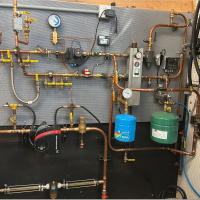Welcome! Here are the website rules, as well as some tips for using this forum.
Need to contact us? Visit https://heatinghelp.com/contact-us/.
Click here to Find a Contractor in your area.
If our community has helped you, please consider making a contribution to support this website. Thanks!
Triangle Tube Prestige heat exchanger corrosion
Options
Comments
-
Oh—and I should add that there are bluish white plastic particles in the kitchen and bathroom aerators. That made one plumber wonder whether the tank has a pvc pipe for cold water that is deteriorating.0
-
I talked more to the plumber yesterday and researched the soot that we might have. Magnesium or zinc anodes could cause the black soot. I can’t find if the Triangle Tube PE 110 has an anode in its tank. Has anyone actually worked on one and opened it up to see? That might determine if I pay to repair the system or replace it. 10 years for a boiler doesn’t seem long enough.0
-
To be clear, an ANODE ROD would be in your indirect water tank--if the mfg. designed it with one. It is NOT in the boiler. If your tank was designed with one...it may still be in there, or not. It is sacrificial. That is its purpose, If gone, it should be replaced.0
-
HeatFlo is the only stainless indirect that I know with an anode rod. Mostly they are in glass lined steel tanks.Bob "hot rod" Rohr
trainer for Caleffi NA
Living the hydronic dream0 -
Hi, Sometimes the black "soot"you find in the water comes from deteriorating black rubber inside of braided flex connectors, like live on top of water heaters. The white, tan or blue plastic bits can be from a failing dip tube. Have a close look at the bits and see if they are all the same thickness, but have a slight curve to them. This would indicate bad dip tube.
Yours, Larry1
Categories
- All Categories
- 87.3K THE MAIN WALL
- 3.2K A-C, Heat Pumps & Refrigeration
- 61 Biomass
- 429 Carbon Monoxide Awareness
- 120 Chimneys & Flues
- 2.1K Domestic Hot Water
- 5.8K Gas Heating
- 115 Geothermal
- 166 Indoor-Air Quality
- 3.7K Oil Heating
- 77 Pipe Deterioration
- 1K Plumbing
- 6.5K Radiant Heating
- 395 Solar
- 15.7K Strictly Steam
- 3.4K Thermostats and Controls
- 56 Water Quality
- 51 Industry Classes
- 50 Job Opportunities
- 18 Recall Announcements

